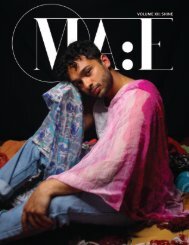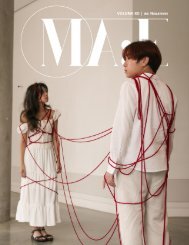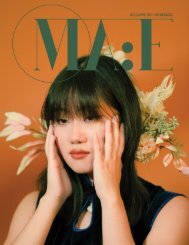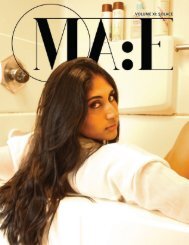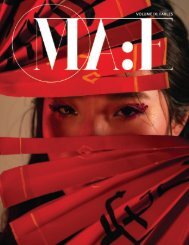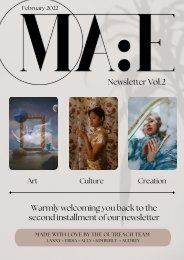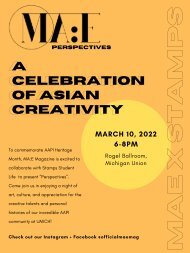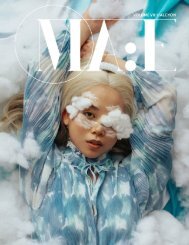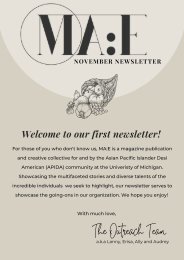VOLUME V: DEFIANCE
The theme of this edition is Defiance, which can be defined as “open resistance and bold disobedience.” With a community as unique and diverse as the one we serve, MA:E Magazine is proud to highlight words and works of all kinds in this edition. Katherine Song in Atlanta, and to Writing as Ourselves. Nellie Shih in Navigating Disconnect. And all of the brilliant photographers who tackled the relative ambiguity of the theme head-on, and imbued it with their own creative visions and definitions of the term.
The theme of this edition is Defiance, which can be defined as “open resistance and bold disobedience.” With a community as unique and diverse as the one we serve, MA:E Magazine is proud to highlight words and works of all kinds in this edition. Katherine Song in Atlanta, and to Writing as Ourselves. Nellie Shih in Navigating Disconnect. And all of the brilliant photographers who tackled the relative ambiguity of the theme head-on, and imbued it with their own creative visions and definitions of the term.
Create successful ePaper yourself
Turn your PDF publications into a flip-book with our unique Google optimized e-Paper software.
Fashion
WWW. MAEMAG.COM
A New Interest-Based
Magazine for the
APIDA Community
Beauty
Culture
Stories
Photo
Art
Health
Wellness
And
More
Magnetize
APIDA
:
Empowerment
VOLUME V:DEFIANCE
Contents
05
Dearest Reader,
05 Editor’s Letter
06 Skin-deep: In Defiance of Asian Stereotypes
08 Unknowable Thing
10 Defiance
12 Out of Bounds
20 Navigating Disconnect
22 Unbound
28 Spring Showers
30 Atlanta, and to Writing as Ourselves
34 Red
42 Credits
Cover Page | Volume V
| Photographer & Editor
Kat Yang
| Editor & Layout
Christine S Park
| Model
Kat Yang, Debbie Dong
With this edition, we mark a full year
since Zoom calls and the beginning of “the
new normal”. In this year, so many things—
both good and bad—have happened within our
community and in the larger world around us.
Yet, we can’t help but feel so incredibly lucky
that our organization has been able to flourish
in this time of great turbulence.
So today, we write not as MA:E
Magazine, but as four individuals within the
APIDA community who dreamed for greater
representation and creative freedom and saw
an opportunity for it on our campus. Though
we initially connected through our shared
interests of fashion and beauty, in the past two
years MA:E has expanded to be a platform that
encompasses so much more.
When #StopAAPIHate started to
dominate our Instagram feeds and increasing
reports of heinous violence and discrimination
against our brothers and sisters cropped up all
around the country, we struggled with what
action steps we could take. Maybe repost a
couple resource carousels, send out a quick
“we stand in solidarity” story, or put on an artcreating-feelings-venting-donation-matching
event. Ultimately, few of our initial plans
came to fruition as we buried ourselves in
doom-scrolling habits that left us feeling both
overwhelmed and helpless.
It took some time to realize that in times
of pain, there is no “right” thing to do. There
are certainly things that can help, whether it be
by spreading awareness, raising much needed
financial resources, or by simply taking a break
from social media.Possibly the worst thing one
could do is feel pressured to act without taking
the time to honor their own feelings.
So, we took time to rethink our purpose
and mission behind creating MA:E. How it was
meant to become a platform for people just
like us looking for a place where their identities
could be celebrated, where their creativity could
be expressed, and where their stories could be
told. And how at the end of the day, there will
always be a need to elevate the voices of those
who often go unheard, and that there can never
be enough room for them to do so. In other
words, we realized that rather than being a
spokesperson for our community, MA:E should
be a platform to amplify voices that have always
had so much to say.
The theme of this edition is Defiance,
which can be defined as “open resistance and
bold disobedience.” With a community as
unique and diverse as the one we serve, we
are so proud to highlight words and works of
all kinds in this edition. Katherine Song in
Atlanta, and to Writing as Ourselves. Nellie
Shih in Navigating Disconnect. And all of the
brilliant photographers who tackled the relative
ambiguity of the theme head-on, and imbued
it with their own creative visions and definitions
of the term.
For every artist, writer, team member
and contributor, the act of occupying space,
creating, and sharing with the world is defiance.
So with that being said, thank you for allowing
us the time to process, grieve, and heal. We are
so excited to present to you the fifth edition of
MA:E, and as always, please enjoy.
With love,
Anabel Nam, Audrey Ling,
Christine Park, and Katherine Yang
MA:E Co-Founders
Skin-deep:
Written by | Tian Yeung
Illustrator | Michelle Kim
In Defiance of Asian Stereotypes
I could oblige. Many people often argue with me and
minimize the negative effects of this stereotype by saying
that it’s not that bad because it’s a “positive” stereotype.
Well, I disagree. I have felt the pressure of this stereotype
since I was a child, and sometimes I am surprised at the
fact that I didn’t crumble from it. Looking back now, I
also know that if this stereotype didn’t exist, I wouldn’t
have wasted my time on math, something that I didn’t
even like. Instead, I would’ve spent more time on things
that I actually enjoyed: reading and writing. The false
belief that these Asian stereotypes are “positive” is a
main reason why they are still being perpetuated.
Of course, there are many more Asian stereotypes
out there, and it’s impossible for me to cover them all
here. But by now, my hope is that you get the point. So,
to answer the question of how we can stand in defiance
of these stereotypes, other than calling someone out
explicitly, here is an alternative: ask them questions. It’s
no secret that people don’t like it when they are told that
they are wrong. Some may hold on to their beliefs more
stubbornly and even become violent. So, to de-escalate
a situation or avoid having a conflict, ask them why they
said what they said: Why is that funny? What do you
mean? Why do you think that? By asking questions,
they will have to reflect on what they said and doing
so will hopefully lead them to realize the wrongness of
their words. If I could travel back in time to that day in
my chemistry class, I would look Mrs. C in the eyes and
ask her, “What do you mean I need a translator?”
I
often feel like the color of my skin precedes me, and
the stereotypes associated with it define me. And not
without good reasons. You see, the thing about Asian
stereotypes is that they are so normalized, so accepted
by society, that they are usually hidden, brushed aside, or
disguised as positive. Now think about growing up with
these “messages,” not knowing that they are stereotypes,
that they shouldn’t be or don’t have to be true, until you
have inadvertently let them define you. It’s tragic, isn’t
it? So how can we stand in defiance of these stereotypes?
Well, we have to first start with acknowledging what
they are.
Let me take you all the way back to my
freshman year of high school, to an incident that will
unfortunately resonate with many Asian Americans.
There I was, fourteen years old, extremely introverted
and a bit awkward, seated in my chemistry class. The
bell signaling the end of class finally sounded, and as I
was about to leave, Mrs. C, my chemistry teacher who
happened to not be Asian, stopped me. She looked at
me with concern in her eyes and said, “Do you need
a translator for the quiz next week?” As I heard those
words, my heart sank. You see, I didn’t talk much at
school back then because of my shyness, but I was
undoubtedly fluent in English. So, on one hand, I
appreciated the fact that she clearly wanted to help.
On the other hand, however, I was deeply offended
because yet again, due to my appearance, I was seen as
a foreigner. More importantly, her words sent a message
to me: who I am underneath the surface doesn’t matter.
Being so shocked by her words at that moment, I didn’t
know how to reply but to tell her “No, thanks.” As you
can see, this is how accepted Asian stereotypes are.
To drive home the point, here’s another example
of a common Asian stereotype. All my life, I was
assumed to be good at math, and to be honest, I liked
the compliments. So even though I didn’t have a natural
knack for math and didn’t particularly like the subject,
I worked extra hard in my math classes. This way, when
classmates asked me for help on their math assignments,
Why is that funny? What do you mean?
Why do you think that? Why is that funny?
What do you mean? Why do you think
that? Why is that funny? What do you
mean? Why do you think that? Why is that
funny? What do you mean? Why do you
think that? Why is that funny? What do
UNKNOWABLE THING
BY by CIALE ciale
Remember that.
That before you were
Hate and Heartache,
You are soil and starlight--
Possibility incarnate.
-- MORO
I
hear Moro’s words in the shape of my
own voice, filling my brain space with
oxygen and exhaling a prayer that
surrounds me. I feel held by her wisdom as she
thanks me into being. Unknowable Thing is an
original movement meditation based on the
1997 Studio Ghibli classic, Princess Mononoke,
directed by Hayao Miyazaki. Inspired by
Ritual Poetic Drama and choreopoetry (based
in the African continuum), Unknowable Thing
follows (and guides) the coming-of-age story of
the wolf girl, San, exploring her adolescence
with her tribal mother, Moro, and reconciling
her humanity in relation to her biological
mother, Eboshi.
It has been such a generative process for me
as both the playwright and solo performer to
learn how to trust my own work and belong
with my gifts — gifts that my training sought
to stamp out of me. Institutional academia
over-emphasizes intellect and rationale above
embodiment and somatic healing. Now more
than ever, as we become more and more
inundated with Zoom calls, it is harder for
me to drop into my body, to ground myself
from the neck down. I craved to center my
wholeness through movement, breath, and
poetry. To ritualize that which I do not know,
but can feel.
How may we embody language and write movement?
How may we develop an attraction to the unknown?
These questions were so lovingly explored
between me and my collaborators: Samantha
Estrella, Amelia Baumann, and Dana
Pierangeli. Each of us exchanged breath and
co-created at the speed of trust, as Rev. angel
Kyodo williams and adrienne maree brown
would say. Although the process was far from
ideal (as is the case with most creative endeavors
in academic settings), I feel so grateful for the
learning curve to develop my own work and
believe in it, too. Trust is a bodily sensation,
after all.
Unknowable Thing, both the process and the
filmed product, is an invitation for practice:
to breathe more than we think, surrender
more than we resist, and allow more than we
understand.
(Unknowable Thing will be premiering this May
through the Theater and Drama Department’s
2021 Playfest along with 5 other original
solo performances. Photos by Beto Soto @
betosotophoto.)
Photography | Beto Soto
Written by | Priya Dandamudi
Graphic Designer | Summer Nguyen
Defiance
/dəˈfīəns/
noun
: open resistance; bold disobedience.
Defiance
/dəˈfīəns/
noun
: open resistance; bold disobedience.
디파이언스 (n)
:(공개적으로 하는) 반항[저항]
Artwork/Layout | Christine S Park
OUT OF
BOUNDS
ut of bounds out of bounds out of bounds out of bounds out of bounds out of bound
ut of bounds out of bounds out of bounds out of bounds out of bounds out of bound
There is a continuous pressure to be constantly
hard-working. The epitome of going against one’s fear
of not fulfilling one’s expectation is to be carefree. There
is a stigma that if one does not work hard enough, then
they will not do well in the future. This stigma prevents
people to feel the need to care of themselves and let
their minds recharge from the burdens of life.
Photographers & Editors | Anna Cao, Emily Cao
Model | Keri Yang
Layout Designer | Emily Cao
Fashion | Carolyn Zhang
nds out of bounds out of bounds out of bounds
nds out of bounds out of bounds out of bounds
NAVIGATING
Written and Illustrated by Nellie Shih
Layout Design by Jenny Suh
Disconnect
unbound
Combining a traditional element of South Asian clothing called a ‘dupatta,’ typically
worn by women, with Western clothing represents a fusion of the two cultures defies
the idea that Asian Americans can only relate to one culture or the other, and instead
pushes the idea that both can be embraced without taking away from each other.
Photography & Editing | Youmna Khan & Amber Syed
Models | Zayna Syed & Tye Kalinovic
Layout Design | Anna Cao
Video | Lisa Ryou
MICHAEL YEUNG
YAYME
PK MOON
KETAN REVANKAR
Collaboration
JKSN
CROWS
ELOMEL
PK MOON
@SEOUL JUICE
visit @officialmaemag or
https://www.maemag.com
NAMIX
Graphic Designer | Zara Ahmed
Atlanta,
and to
Writing as Ourselves
“I will never write a diaspora story again.”
This is how I end a recent poem of mine, a
grievance about how clumsy and trapped I feel
as an Asian-American writer. Somehow, every
time I reach to incorporate my identity into my
work, I am met with the paralyzing insecurity
that any connection to my intimate experience
is somehow cliché. I can’t write about someone
with the last name Kim, Park, or Lee—that’s
exactly what people expect of me. I can’t write
about the invisibility of existing as an “other”
in predominantly white spaces; people express
that sentiment all the time, more articulately
and with more grace than I can muster. I will
sound bitter, and I will seem strategic, as if I
stretch my cultural experiences just as fodder
for consumption. I feel as if people are tired of
hearing about lunchbox moments or incorrect
name pronunciations, so I take care to carve
my way around “Asian-American tropes.” I
have to write characters who are ethnically
ambiguous. I have to make things universal.
I have to prove to everyone, and above all, to
myself, that I am capable of garnering approval
without using my identities as a crutch. As the
model minority, it seems I am often made to
think of them as a crutch.
These thoughts have always been
familiar and cyclical, to the point where I
began to convince myself that I should no
longer be attempting to write about anything
that I personally have a stake in. I am secure in
being a Korean woman, so there’s no reason to
push myself to engage in that painful digging
that telling our stories requires. My very
privileged experience in this country and I,
what could we possibly contribute? But even
with attempts to numb my brain and jump
through hoops to escape taking on depicting my
likeness, I still craved the representation that
seemed to flow so easily from other sources.
Growing up, any cartoon character with black
hair and ambiguous features was Asian to
me. I remember feeling frustrated that the
TV adaptation of Little Fires Everywhere didn’t
feature Asian women as the main characters,
simply because they had always been Asian in
my head, as the author is, and as I am. The
dissonance was stunning—how could I avoid
writing about my identity like the plague and
then search for reassurance and representation
everywhere else?
Illustrator | Lucy Sun
Written by | Katherine Song
Layout Design | Christine Park
I read the news about Atlanta at one
or two in the morning the following day. It hit
me like a train. I felt the lump in my throat
sink down to my stomach like an anchor,
carrying with it an impossible weight. The
bright light of my screen, displaying invasive
words like “hate crime” and “sex addiction”
that burrowed into my eye sockets. The
grief was physically overwhelming, yet I
could not break my gaze. I doom-scrolled
instead of sleeping that night. I couldn’t stop
thinking about how the killer must have
viewed his victims to commit something so
heinous, each a whole person reduced to a
mere object. Six out of eight of the victims
looked like my family members, my friends,
and me. And in his eyes, we must have
been things, expendable and owing him
something. I was forcefully reminded that
I am not distinguishable to some. I am not
thinking or feeling or autonomous. No, I am
black hair and a body that invites violence.
I am not really alive—not in the sense that
I deserve protection or control over my own
sexuality.Sitting with these thoughts left me
an incoherent mess.
In a thorough search for solace, I found
myself comforted by one thing: hearing and
reading and absorbing how my Asian peers
vocalize their grief and anger. Their ability
to remain articulate and purposeful when
I felt so impossibly reduced was shocking,
inspiring. There were moments when I
wondered if I could ever evade the intensity
of constant objectification and continue to
live as I had been. My community proved to
me that it is possible.
Not too long ago, I wanted to write
ambiguously, in a way that divulged nothing
about my identity. I wanted to be seen as a
good writer, not a good Asian writer. But I
am Asian; I can’t control that my identity is
so visible, something I can never separate
myself from. I don’t want to. It would be
a disgrace to those who never asked to
become symbols of a movement. To those
who become headlines, hashtags, mourned. I
choose to celebrate my identity in one of the
few public ways I can. Writing: as myself, for
myself. To create my own form of reassuring
representation and ensure that members
of my community know that striving for
proximity to whiteness by erasing yourself is
never worth it. Under any guise.
As Alexander Chee wrote, “I could
finally see how tired I was of the idea of
having to pretend to be a white man, or
be like one. Better to catch the energy that
rises when I fling myself at everything I
fear writing.” To reject the premise that I
am something instead of someone, I will
no longer censor myself, nor will I refuse
myself permission to repeat what has already
been said. Why should my writing be made
universal, when my experiences are not? My
characters written as ethnically ambiguous,
when I myself am not? Whose approval could
matter to me more than that of my very own
community, if they are the only ones who
understand what I mean precisely?
Just as I still crave media representation
in a shallower sense, I hunger for more words
written by people who know my history. It is
with their voices that we inch closer to the
truth. Korean reporters who interviewed
Korean massage parlor workers in Atlanta
and divulged the specifics of the shooter’s
racist threat. Asian-American writers who
demanded the media shift their attention to
the victims rather than the killer and his “bad
day.” There can never be enough storytellers
who possess the intimate details. There
can never be enough of us to scream of the
consequences of racist misogyny, to redirect
attention to racialized violence, to declare
these events patterns from colonialism and
imperialism rather than isolated incidents,
to remind that yellow peril supports Black
power, and to condemn the police state that
is killing us all.
Delaina Ashley Yaun. Paul Andre
Michels. And my sisters. Xiaojie Tan. Daoyou
Feng. Hyun Jung Grant. Soon Chung Park.
Suncha Kim. Yong Ae Yue. A whole world
existed in each of them, and these losses
are incomprehensible. We hold them in our
thoughts, and we ask you not to forget.
Personally, I ask you to directly defy the
condition of the violence against them, the
idea that they were not distinguishable. Make
yourself distinguishable. We need to tell our
own stories.
When pictures flash across a screen
They hand us flowers
and give us advice
White carnations are for mourning
take care, be quiet
and keep your head down.
But today from under a shadow,
we demand more light
Red with anger
white carnations in hand
defy obedience
shout our stories
and rise to fight back.
Photography/ Editing | Katherine Yang
Models | Katherine Yang, Debbie Dong
Graphic Designer | Christine S Park
SOCIAL MEDIA TEAM
Sapphira Ching
Duy Anh Vo
PHOTO TEAM
Alice Liu
Anna Cao
Emily Cao
Hanna Dong
Joan Xiao
Keri Yang
Heather Sun
Amber Syed
Jess Kim
Fatema Dohadwala
Jacob Yu
Katrina Stebbins
Nellie Shih
Younma Khan
PRESIDENT PUBLISHER
Anabel Nam
EXECUTIVE EXTERNAL DIRECTOR
Audrey Ling
EXECUTIVE CREATIVE DIRECTOR
Christine S Park
EXECUTIVE INTERNAL DIRECTOR
Katherine Yang
PHOTO/VIDEO/FASHION DIRECTOR
Michelle Lin
PRODUCT MANAGEMENT DIRECTOR
Fion Lin
PRINT DIRECTOR
Priya Dandamudi
PUBLIC RELATIONS DIRECTOR
Sania Farooq
Check us out on Social Media
VIDEO TEAM
Madeline Kim Lisa Ryou
Abby Lee
Jess Kim
FASHION TEAM
Carolyn Zhang Anthony Huynh
Younma Khan
DESIGN TEAM
Summer Nguyen Michelle Kim
Emily Cao
Anna Cao
Jenny Suh
Zara Ahmed
Lucy Sun
PRODUCT MANAGEMENT TEAM
Yilin Fang
Linh Tran
Kimberly Liang Derek Wen
Sapphira Ching
PRINT TEAM
Nellie Shih
Tian Yeung
Katherine Song
PUBLIC RELATIONS TEAM
Stephanie Kim Amber Wei
Christy Yue
instagram.com/officialmaemag
facebook.com/officialmaemag
https://www.youtube.com/channel/
UC-lfPUzpyQLKo56axQq1QkQ
MA:E OFFICIAL WEBSITE
www.maemag.com





